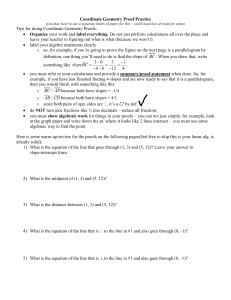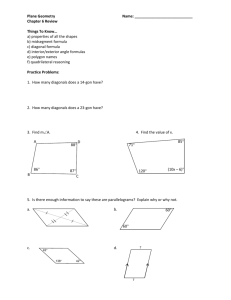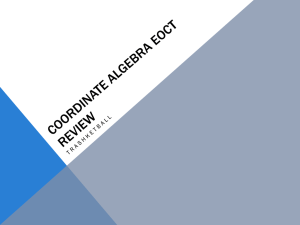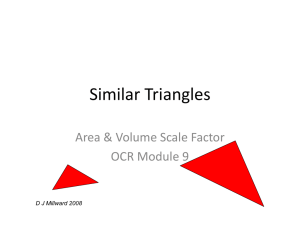click Here - Kendriya Vidyalaya HVF AVADI
advertisement
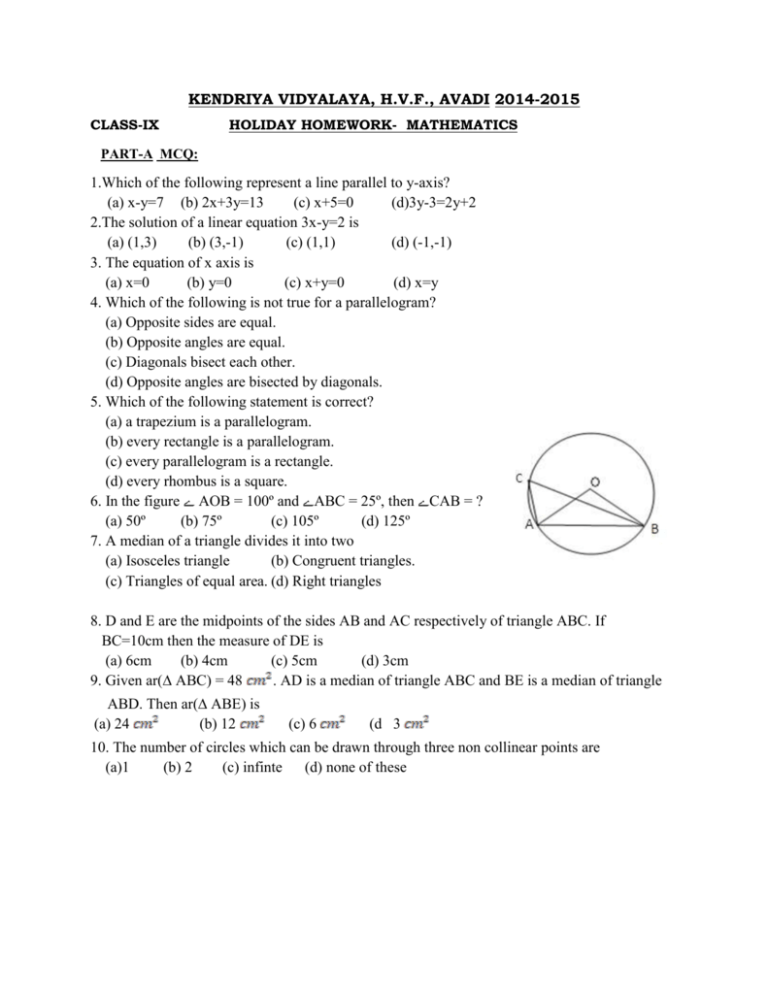
KENDRIYA VIDYALAYA, H.V.F., AVADI 2014-2015 CLASS-IX HOLIDAY HOMEWORK- MATHEMATICS PART-A MCQ: 1.Which of the following represent a line parallel to y-axis? (a) x-y=7 (b) 2x+3y=13 (c) x+5=0 (d)3y-3=2y+2 2.The solution of a linear equation 3x-y=2 is (a) (1,3) (b) (3,-1) (c) (1,1) (d) (-1,-1) 3. The equation of x axis is (a) x=0 (b) y=0 (c) x+y=0 (d) x=y 4. Which of the following is not true for a parallelogram? (a) Opposite sides are equal. (b) Opposite angles are equal. (c) Diagonals bisect each other. (d) Opposite angles are bisected by diagonals. 5. Which of the following statement is correct? (a) a trapezium is a parallelogram. (b) every rectangle is a parallelogram. (c) every parallelogram is a rectangle. (d) every rhombus is a square. 6. In the figure ےAOB = 100º and ےABC = 25º, then ےCAB = ? (a) 50º (b) 75º (c) 105º (d) 125º 7. A median of a triangle divides it into two (a) Isosceles triangle (b) Congruent triangles. (c) Triangles of equal area. (d) Right triangles 8. D and E are the midpoints of the sides AB and AC respectively of triangle ABC. If BC=10cm then the measure of DE is (a) 6cm (b) 4cm (c) 5cm (d) 3cm 9. Given ar(∆ ABC) = 48 . AD is a median of triangle ABC and BE is a median of triangle ABD. Then ar(∆ ABE) is (a) 24 (b) 12 (c) 6 (d 3 10. The number of circles which can be drawn through three non collinear points are (a)1 (b) 2 (c) infinte (d) none of these PART-B 1. If the point (4,-6) lies on the graph of 5x-ay+4=0, find the value of a. 2. Express the equation 5x= – 9y in the form of ax+by+c=0 and indicate the values of a,b and c. 3. In triangle ABC, median AM is produced to D such that AM=MD. Prove that ABDC is a parallelogram. 4. The angles of a quadrilateral are in the ratio 3:4:6:7, find all the four angles of a quadrilateral. 5. The area of a parallelogram is 338cm2. If its base is twice the corresponding altitude, determine the base and altitude. 7. If the diagonals of a parallelogram are equal then show that it is a rectangle. 8. Find the length of the chord of a circle, of radius 13 cm, at a distance of 5 cm from the centre. 9. In the figure 1, O is the centre of the circle. QS=SR and ےSQR=25º. Find ےQPR. Figure 1 Figure 2 Figure 3 10. In the fig 2, ےACB=59º and ےDBA=35º. Find ےDAB. 11. In the fig 3, O is the centre of the circle. If ےPAO=15º and ےPBO=20º, then find ےAOB. 12. Solve the equation 2y+1=y –3 and represent the solution on (i) the number line (ii) the Cartesian plane 13. In the fig. PM and RN are respectively the bisectors of the opposite angles P and R of a parallelogram PQRS. Show that PM || NR 14. ABCD is a rhombus and P,Q,R,S are mid points of the sides AB,BC,CD and DA respectively. Show that the quadrilateral PQRS is a rectangle. 15. In the fig 1, CD || AO || TG. Prove that ar(COT)=ar(DAG). fig 1 fig 2 16. In the fig 2, AB || DC. Show that ar(BDE) = ar(ACED). 17. In the fig 3, AD and BE are medians of ∆ ABC and BE || DF. Prove that CF= AC 18. Prove that equal chords of a circle subtend equal angles at the centre. 19. Draw the graph of the equation x-2y=3. From the graph find the coordinates of the point when (i) x = -5 (ii) y = 0 20. Draw the graph of 2x +y =7. Write the points where the line meets x and y axes. 21. Prove that a diagonal of a parallelogram divides it into two congruent triangles. 22. Construct a triangle a ABC in which BC=7 cm, ےB=75º and AB+AC=12 cm. 23. In the figure P is a point in the interior of a parallelogram ABCD. Show that (i) ar(APB) + ar(PCD) = ar(ABCD) (ii) ar(APD) + ar(PBC) = ar(APB) + ar(PCD) (Hint: Through P, draw a line parallel to AB) fig 3 24. Prove that the angle subtended by an arc at the centre is double the angle subtended by it at any point on the remaining part of the circle. 25. Construct a triangle PQR in which º, ےR=75º and its perimeter is 11cm. Write the steps of construction. 26. Construct a triangle ABC in which BC=5 cm, ےC = 60º and AC-AB=1.5 cm. 27. Construct a right triangle ABC, right angled at B, in which BC= 4 cm and AC+AB= 8 cm. 28. Draw the graph of the linear equation 5x–2y=10. At what points, the line cuts the x-axis and the y-axis. 29. PQ is a line parallel to side BC of a triangle ABC. If BE || AC and CF || AB meet PQ at E and F respectively, show that ar(ABE)=ar(ACF). 30. If two intersecting chords of a circle make equal angles with the diameter passing through their point of intersection, prove that the chords are equal. 31. Construct a triangle ABC in which ےA=60º, ےB=90º and AB+BC+CA=13cm. 32. ABCD is a cyclic quadrilateral in which AC and BD are its diagonals. If ےDBC=55º and ےBAC= 45º, Find ےBCD. 33. Draw the graph of the equation 5y = 3x+18. From the graph check whether (-2,4) is the solution of the linear equation or not. 34. Show that if the diagonals of a quadrilateral bisect each other at right angles then it is a rhombus 35. Diagonal AC of a parallelogram ABCD bisects ےA. Show that (i) it bisects ےC also. (ii) ABCD is a rhombus. 36. Show that the diagonals of a square are equal and perpendicular to each other. 37. Prove that each angle of a rectangle is a right angle. 38. Prove that parallelograms on the same base and between the same parallels are equal in area. Figure 1 Figure 2 39. In the fig 1, O is the centre of the circle with radius 5 cm. OP ┴ AB , OQ ┴ CD, AB║CD, AB=6 cm and CD=8 cm. Determine PQ. 40. In the fig 2, PS=SR, ےRPS=54º and ےPRQ=26º. Calculate (i) ےTQR (ii) ےRTQ

